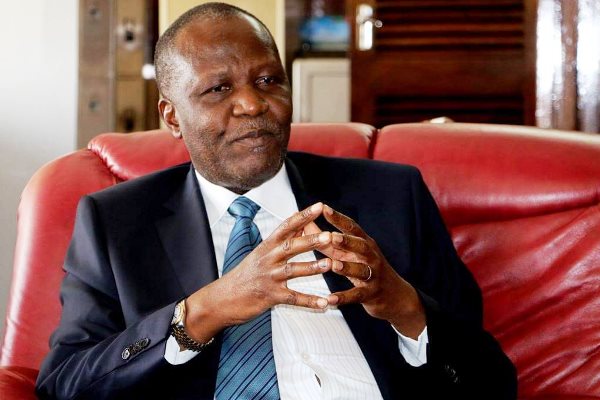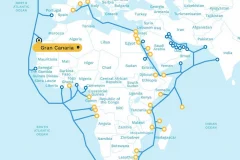Zambia’s tech ecosystem has seen unprecedented growth in recent times, with industry players endorsing it as the next major hub in Africa. Honourable Felix Mutati, the minister of technology and science, tells TechCabal about the state of the tech industry in the country.
Two months ago, when pan-African e-commerce startup Wasoko announced its entry into the Zambian market, Daniel Yu, the company’s founder and CEO, cited “high smartphone usage and a pro-business government administration keen on expanding the country’s digital economy” as the reason for setting up shop in the southern African nation.
Wasoko is not the only tech company to recently set up shop in “Zed”, as the country is affectionately known by its 19 million inhabitants. Subscription video-on-demand platform Wi-flix, technology infrastructure company Liquid Intelligent Technologies, crypto exchange VALR, and fintech unicorn Chipper Cash have all entered the Zambia market in the last year. inq. has also announced it will be setting up its Artificial Intelligence centre of excellence in the country.
So promising is the Zambia tech ecosystem that Vitalik Buterin, co-founder and inventor of Ethereum, the world’s second-largest cryptocurrency, has also expressed his support for its tech scene following a 2019 visit to the country and a virtual meeting with President Hichilema in 2022.
So what are they doing differently in Zambia that is making a lot of technology companies want to do business there? TechCabal spoke to Honourable Felix Mutati, Zambia’s minister of technology and science, about what policy measures the country has employed to boost technology, the challenges the government has faced in this process and how they have addressed them. He also speaks on what the future holds for the technology sector in Zambia and why investors should flock to the southern African nation.
TechCabal: How has Zambia managed to create an enabling environment for a fast-growing tech ecosystem in the last two years?
Felix Mutati: First of all, we carried out an assessment in terms of how prepared the economy was to be able to be driven by technology. When we did that assessment, about two years ago, we found that if we were going to have a digital transformation of the country, we were only 45% ready. From those findings, we knew that there was some heavy lifting to be done to get that readiness from 45% to 100%.
That heavy lifting was to be done through five pillars. The first pillar was the concept of a digital government and this basically means how does government work itself incorporate technology? How does government work with the citizens? And how does government work with business? From that assessment, I mentioned, we had realised that government preparedness in that regard was around 34%. The next pillar we assessed was digital financial inclusion where we were at almost 70%. In digital literacy and skills, were at 34% while for the digital infrastructure pillar, we were at 54%. On the last pillar, digital innovation and entrepreneurship, we were at about 40%.
Having defined the pillars and assessed our preparedness in each of them, we had an idea of what we needed to do in each of the pillars to move forward. We understood that first, we needed to create a correct policy and from that, we began the journey to construct the ICT policy which was approved by the cabinet last week. In terms of the enabling legal framework, we looked at our data protection and cybersecurity and cybercrime in electronic transactions because those are key in terms of having an enabling environment that drives the digital transformation of the economy. So, that was the first phase.
The next step was identifying ways to support our preparedness in those pillars. Number one was facilitating connectivity. How do we use digital infrastructure to connect businesses, citizens and government? What sort of technology did we need to deploy? So, in terms of enabling connectivity, we looked at a combination of communication towers and satellites. We did a proof of concept in ten provinces and identified that it would be cheaper to use low-orbit satellites in places where planting communication powers would be impractical and expensive. Having done that, our goal was to have 100% coverage by 2030 but because of the investments that we have done in the last two years, we have revised that target to have 100% by 2024.
The next step was facilitating what is called a national digital identity. In order to have this digital identity, we needed to have a harmonisation of data because what we have now is an identity that is not connected. Data literally stands alone. Now the cost of facilitating that harmonisation is enormous to the government. I’ll give you an example. There are some government programmes that we are providing to citizens and because each programme is independent of the next programme, there are silos. To address that, we embarked on what we call “interoperability system handshake”. Through that, we can connect all these platforms so that they can communicate with each other across the entire digital ecosystem. Financial sector systems can talk to government systems which can talk to citizen systems and so on.
Then there was the pillar of cyber resilience. By cyber resilience, it means that when you transact, the transaction must be complete and we are waiting to complete that because that is the only way you can create trust and confidence in digital technology, hence increasing adoption in the process. Otherwise, if you don’t have trust and confidence in digital technologies, it will not grow.
The last step to address was concerning partnerships and collaborations. Here, we are saying how do we collaborate with citizens and the private sector for success. We found that what was holding back investments, particularly from the private sector, were some things including administrative barriers, procedures and other rigidities. I’ll give an example. If a telco company want to plant a tower, the regulator needs to carry out an environmental assessment. They have to go and assess where they want to plant the tower and give the company the requisite certification. Imagine now that company is planting 200 towers in various locations in Zambia and all of those need certification while the department only has a team of four or five people. It would take a long time and that’s for just one company.
So we revised and said, let’s break down this barrier, let them plant and then the assessments will be done. The other thing we did was to remove tariffs and duties on all digital infrastructure. Our thinking is that unless you can bring in the digital infrastructure, you cannot generate tax revenue. So bring them in and once they’re inside the house, then you can start with the taxes. So in 2023, we removed the taxes and that opened the door for investment which allowed companies to plant towers and generate revenue. We are then able to collect greater taxes continuously instead of on a once-off basis. The other thing that we did was think about how we could reduce the carrying costs of digital infrastructure on the economy. We said, Zambia has three telcos so there is no reason why each one of them must be able to plant a tower in the same location. So we came up with the policy of what we call co-location. We said there will be one tower and the three of you can use it. put your activated meant there. The idea is that telcos shouldn’t compete on infrastructure, but rather on just providing services.
Before we achieved a debt restructure about two months ago, Zambia was a defaulting nation so we could not access international capital. Now that we have got that out of the way, the private sector in telco can raise international capital to invest, so we have literally unlocked that pipeline of international capital, which was previously blocked because Zambia was a default. Lastly, to facilitate all this, we have had continuous engagements and compared notes with all the stakeholders including the private sector, government and citizens and we have come up with one mantra about what matters to the citizen. We call these the three A’s. One, is the service accessible? Is it affordable? Is it accordible? That’s all that matters. All these other things are important but at the end of the day, the citizen must be able to use digital resources without any delay or inconvenience and the elements of that mantra covers this.
What challenges did the government phase in implementing those aforementioned pillars?
FM: There have been multiple challenges and resistance. An example is concerning the tower co-location I mentioned. Traditionally, every telco planted its own tower because, in their perception, they were holding on to a specific market. Telling them to settle on using one tower amongst themselves was obviously met with some resistance but now they’re seeing the benefit in that the amount of investment they have to make in infrastructure is now much lower. Another challenge was in the process of creating the national digital idea as part of the digital identity pillar as the systems which were in place were not connected and facilitating interoperability between them was a significant challenge.
In general, any change that you’re going to make, whether it’s digital or anything else in life really, is going to face resistance until the benefit of that change persuades the worthwhile recipient. For us, we understood this and sought to create as much value as possible for all stakeholders so that at the end of the day, after all these changes have been implemented, the stakeholders can say “Thank you digitalisation”.
One of the provisions of Zambia’s debt restructuring is for the country to identify sectors and industries which can accelerate the country’s economic growth. Does the government recognise tech as one of these sectors?
The tech sector this year is projected to grow by 40% which is huge. That comes first of all, with opportunities and jobs in the tech sector. Number two, when you are connecting systems, you are reducing the cost of transactions across the economy, and when you do that, the private sector then begins to grow. So, for us, tech is the fuel that facilitates the growth in agriculture, mining, manufacturing, education, health etc.
I’ll give an example of the influence that technology is having in the financial sector for example. One of the country’s biggest commercial banks is now able to reach and connect with customers all over the country because they are moving from brick-and-mortar banks to digital banks, a process which has been facilitated by the availability of digital infrastructure. So to include that person in rural locations who prefers cash, the bank has agents in these locations who facilitate transactions. These agents can employ up to three people each and if you do the maths, that’s a lot of jobs created as these kinds of services scale.
To the tech community in Zambia, from investors to entrepreneurs to citizens who utilise technology products and services, can you assure them to be hopeful of the impact that government initiatives are going to have on the growth of the country’s technology sector?
Our government is not in the business of delivering hope. We are about outputs because our people are tired of stories. As an example of our commitment to the technology sector, we have set aside 14 million Kwacha (~$740,000) which we are providing by way of grants to innovators that have creative ideas. The grants are meant to help them take their ideas from that ideation phase to practical implementation.
To investors, we have five things to share about why Zambia is an ideal investment destination. Number one is that Zambia is bankable because we are no longer a defaulting country. Number two is that at the centre of doing business in Zambia is adherence to the rule of law. Any investor that does business here can be sure that all processes will be done accordingly. Number three is that we are breaking down the barriers to investment including those around procedures, processes and other forms of rigidity that are holding back investment.
Number four is that we are carrying out extensive reviews of most of our laws that affect business. For example, we are looking at a law called Public Procurement which was designed to be anchored on processes and procedures or not any value. That was the old tradition and we are looking to revamp that. We’re also looking at what to call the public-private partnership legislation to make it effective in easing the process of doing business. The last but not least reason why investors should look to Zambia is that we have a sensible government that will listen to you and engage in dialogue.
Additionally, it is important to note that Zambia is now one of the most connected countries by fibre on the continent. We are connected from the east coast of Africa to the west coast. We are also connected from Cape to Cairo, making us the most ideal location for a technology hub. Also, Zambia, Malawi, Zimbabwe, and Botswana are currently working on moving from what is called a “one-stop border post” to a “non-stop border post” which will significantly enhance trade between the four nations and boost the ease of doing business.
Editor’s Note: Interview has been edited for length and clarity.





















